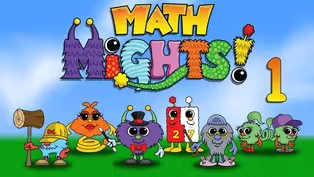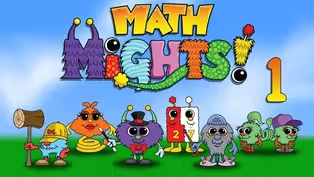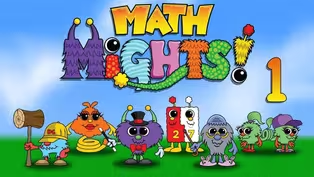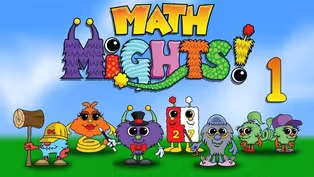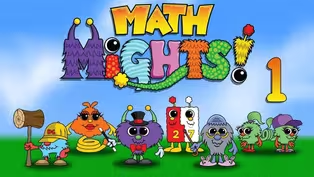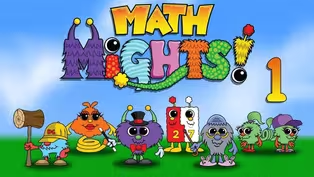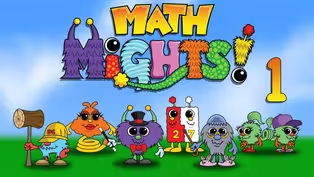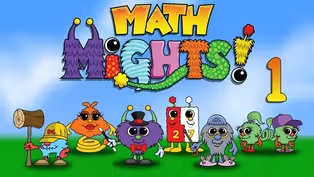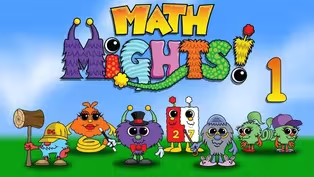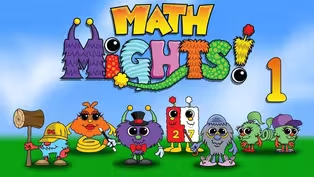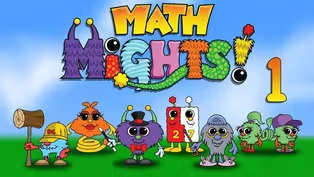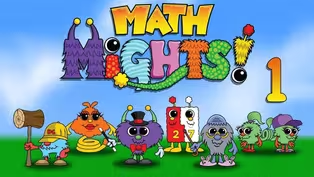Math Mights
Decompose/Compose #'s Different Ways
Season 3 Episode 301 | 15m 59sVideo has Closed Captions
We show you different ways to decompose and compose 2-digit numbers!
Join Mrs. Markavich & Dotson for a Numeracy Talk with the Counting Buddy Senior, then we show you different ways to decompose and compose 2-digit numbers!
Problems playing video? | Closed Captioning Feedback
Problems playing video? | Closed Captioning Feedback
Math Mights is a local public television program presented by Detroit PBS
Math Mights
Decompose/Compose #'s Different Ways
Season 3 Episode 301 | 15m 59sVideo has Closed Captions
Join Mrs. Markavich & Dotson for a Numeracy Talk with the Counting Buddy Senior, then we show you different ways to decompose and compose 2-digit numbers!
Problems playing video? | Closed Captioning Feedback
How to Watch Math Mights
Math Mights is available to stream on pbs.org and the free PBS App, available on iPhone, Apple TV, Android TV, Android smartphones, Amazon Fire TV, Amazon Fire Tablet, Roku, Samsung Smart TV, and Vizio.
Providing Support for PBS.org
Learn Moreabout PBS online sponsorshipMore from This Collection
Video has Closed Captions
Join Mrs. Markavich for a missing addend word problem with Professor Barble! (16m 5s)
Adding Tens-Tens and Ones-Ones
Video has Closed Captions
Join Mrs. Markavich for a missing addend word problem with Professor Barble! (15m 35s)
Write Equations to Match the Strategy
Video has Closed Captions
Join Mrs. Markavich for a missing addend word problem with Professor Barble. (16m 2s)
Video has Closed Captions
Join Mrs. Markavich for a subtraction word problem with Professor Barble. (15m 59s)
Video has Closed Captions
Join Mrs. Markavich for a missing addend word problem. (16m 6s)
Add 2-Digit Numbers & Write Equations
Video has Closed Captions
Join Mrs. Markavich for a word problem with her friend Professor Barble! (15m 59s)
Comparing Numbers Different Ways
Video has Closed Captions
Value Pak shows you the different ways to compare 2-digit numbers. (15m 44s)
Video has Closed Captions
Join Mrs. Markavich for a word problem with her friend Professor Barble! (15m 59s)
Video has Closed Captions
Join Mrs. Markavich for a word problem with her friend Professor Barble! (15m 59s)
Video has Closed Captions
Join Mrs. Markavich & Dotson to talk about numbers with the Counting Buddy Senior! (16m)
Video has Closed Captions
Join Mrs. Markavich & Dotson for a Numeracy Talk with the Counting Buddy Senior (16m)
Video has Closed Captions
Join Mrs. Markavich for Numeracy Talk with Dotson working on conservation to 20. (16m)
Providing Support for PBS.org
Learn Moreabout PBS online sponsorship(bright music) - [Children] Math Mights.
- Hey, first grade Math Mights.
It's Mrs. Markavich here with you today, and we're going to have so much fun with math.
Let's take a look at our plan for today.
Today, we'll do a number talk with our friend Dotson.
And then we'll be decomposing and composing two-digit numbers.
Wow.
That sounds like a lot of fun.
Let's head over and warm up our math brain with our friend Dotson.
(dramatic music) - Hey, Dotson.
Dotson wants you to take a look at our friends on the famous red carpet.
Remember, this is our senior counting buddy, and he is so cool.
He has beads on him that are in two different colors.
Are you ready to take that picture?
I want you to take the picture, hold it there, and then I have a secret question for you to solve.
Ready?
Three, two, one.
Take that picture.
My secret question is this: what was two less than what you saw?
And how do you know?
Ooh.
That's a tricky question.
Let's talk about it a little more.
My friend Natalie says, "I saw 13, and two less than 13 would be 11."
And my friend Shanice says, "I saw 14, and two less would be 12."
Let's take a look at what my friend Natalie saw.
My friend Natalie says, "I saw 13, and two less would be 11."
I'm going to use my counting buddy Senior.
Let's work that out together.
I have one, two, three, four, five, six, seven, eight, nine, 10.
And then we know she said 13.
So I have to keep counting, 11, 12, 13.
And Natalie said, "Two less than 13 would be 11."
So what I'm going to do is just kind of move two of my beads out of here.
And two less would be 11.
Good thinking, Natalie.
Now let's take a look at how my friend Shanice solved this.
Shanice said, "I saw 14, and two less would be 12."
I've got 10, let's count on to get to 14.
I have 10, 11, 12, 13, 14.
And then Shanice said, "I know that two less, which means I would need to take two away, would be 12."
So I'm going to move two beads over.
And I see that two less than 14 is 12.
I have to take a closer look at what I originally saw on my counting buddy Senior.
And what I saw were 13 beads, which means my friend Natalie is correct.
13 and two less would be 11.
Nice work, ladies.
You both did a great job talking about our numeracy talk.
Now it's time for us to talk about our I can statement of the day.
Our I can statement says, "I can decompose and compose two digit numbers in different ways using tens and ones."
Wow.
There sure are a lot of cubes here.
How many cubes do you see?
This will be a whole lot of cubes to count, so I need to take an estimate.
And an estimate is a guess.
And we take that estimate because we would be here all day if we were trying to count all of these cubes.
So we're going to make a good estimate on how many cubes we think we see.
Then we are going to talk about what would be a good estimate.
We might have an estimate that is too low, just right, or too high.
My friend Shanice says, "An estimate of 20 to 40 would be way too low."
Why do you think she would say, "An estimate of 20 to 40 would be too low?"
Well, let's take a look at this.
I see two tens and a whole bunch of ones, and I know if I started putting those ones together, I would have way more than 40 ones.
So I think that I agree with my friend Shanice.
20 to 40 is too low of an estimate.
She says, "Between 81 and 100 is way too high."
And when I think about this and I look at my picture, I can see if I start to organize those, I know that I have more than 40, but do I really have more than between 81 and 100 ones?
I don't think so.
So again, I think I might agree with my friend Shanice.
Finally, she says, "I think 41 to 80 would be about right."
So what I did was I took the cubes that I had and I started making tens.
And now when I look at this, I wonder, "How many cubes do you see?"
I see more groups of 10 and less ones scattered around.
I group them in groups of 10 because it's easier to count by 10.
And if you look in front of me, you can see I have 10, 20, 30, 40, 50, and I have less ones over here.
So, I think now I need to take a better look at my estimate.
And I think that I want to know what would be too low of an estimate, what would be about right, and what would be too high?
Well, my friend Shanice says, "I want to change my answer."
She says now, "I think 50 to 65 is way too low.
And 81 to 100 is way too high."
And I want you to take a quick look at what I have in front of me so I can explain to you why 81 to 100 would be way too high.
Just take a look.
I have one, two, three, four, five tens, and some ones.
And I know that there is no way that this would be any number between 81 and 100.
And Shanice says, "My just about right estimate would be between 66 and 80."
And she knows that because she has 10, 20, 30, 40, 50.
She knows I could probably make at least one or maybe two more groups of 10 to come up with a number that's somewhere between 66 and 80.
Why were Shanice's estimates more accurate the second time?
Because it's easier to count when we group things into tens.
So she took those ones and made tens, and that makes it easier to count, and she was able to count to the number 76.
Great thinking, Shanice.
I think you should kiss your brain.
Now I wonder how many ways can we make 94?
And I get to call on my friend Value Pak.
Hey, Value Pak, come and help me out.
Value Pak wears his numbers on his belly.
He has the number 94.
I wonder, how many ways can we make 94?
Is this the only way?
Let's take a closer look at that.
I have 94 in front of me.
Let's count it together.
10, 20, 30, 40, 50, 60, 70, 80, 90, 91, 92, 93, 94.
And I have the number in front of me up here.
And if I pull it apart, you can see that I have 90 and four ones.
I'm going to cover that back up to show the number 94.
Natalie is wondering, "I wonder if I could break up a 10 into ones, would it still be 94?"
Let's act it out to look at Natalie's thinking.
And I have something really cool to show you.
I have in front of me today a place value board.
And our place value board looks a little different than it normally does.
It still has tens and ones, but on the ones side, I put some 10-frames so that we could break apart a 10 and fill it in our 10-frames.
So, my friend Natalie says, "I wonder if I could take one of my tens and break it apart into ones to show the number 94 a different way."
Let's try it.
I'm going to take my 10 and just set it aside.
And I have another group of 10 right here.
I can't forget about the ones I already have.
So in order to not lose track of them, I'm going to just move them down into the next 10-frame.
Watch me.
I'm just going to slide them right down here like this.
And then I'm going to take that 10 and break it apart into ones.
One, two, three, four, five, six, seven, eight, nine, 10.
Now, if I'm just looking at my ones, I have 10, because I know it takes 10 ones to fill a 10-frame, 11, 12, 13, 14.
Ooh, so now I have a different equation or a different way to write the number 94.
Now I have eight tens and 14 ones.
And I know that eight tens plus 14 ones equals 94.
Wow.
That was awesome thinking, Natalie.
Let's take a look at another way I could break apart 94.
My friend Shanice says, "Hey, if we broke up another 10, would it still be 94?"
Good question, Shanice.
Let's give it a try.
I'm going to pull out another 10.
Just going to set it over here.
I'm going to move those ones down from my second 10-frame because I don't want to forget about them, and I'm going to add 10 more, because this is magically going to break apart.
One, two, three, four, five, six, seven, eight, nine, 10.
Wow.
Look at this.
Let's try to count it.
I have one, two, three, four, five, six, seven tens, and seven tens is 70.
Let's look at my ones.
I have 10, 20, 21, 22, 23, 24 ones.
Wow.
70 plus 24 equals 94.
So yes, Shanice, if I broke up another 10, we would still have the total of 94.
Such awesome work.
Now, looking at the number 94, look at all these different ways that you can break it apart and still get the total of 94.
Now, we're going to play a game, and it is all about riddles.
Do you like riddles?
I love riddles, especially when they're focused on math.
Here goes our first riddle.
I have four tens and 25 ones.
Who am I?
Think about it, friends.
Let's take a quick look at it on my place value board.
What you can see is that I have one, two, three, four tens, and I have 10, 20, 21, 22, 23, 24, 25 ones.
If I put those together, I would say this: 10, 20, 30, 40.
Remember, you can count this as a 10 because it's in a 10-frame.
So, 40, 50, 60, 61, 62, 63, 64, 65.
So that number would look like this.
65.
Did you get it right, friends?
I sure hope so.
We're going to take a look at another riddle.
Keep that math brain thinking.
Our next riddle says this: I am a number 49.
If you represent me with 29 ones, how many tens do I have?
Ooh.
Think about that for just a minute.
I wanted to show you what that looked like on my place value board.
You can see that I have two parts on my place value board but one part is missing.
The tens are missing.
I have 10, 20, 21, 22, 23, 24, 25, 26, 27, 28, 29 ones.
How many tens do I need to make the number 49?
I can count on by 10.
So I want you to say the number 29, and then we're going to count up 10 more, 39.
Hmm.
I'm not there yet.
Let's count more.
Say 39, and 10 more would be 49.
So, I need two tens to get the number 49.
Great thinking, Math Mights.
I have some riddles for you to try on your own.
I suggest that you grab a friend and you try this together.
I know it'll be fun.
Thanks, first-grade Math Mights for joining me today.
We did so many fun things.
We had our counting buddy Senior with us.
We talked about decomposing, which means to take apart, and composing, which means to put together, numbers.
And then we had some great fun with some really cool riddles.
I hope you join me next time on Math Mights.
(bright music) - [Narrator] SIS4teacher.org, changing the way you think about math.
- [Narrator] This program is made possible with funding from the Michigan Department of Education, Governor's Education Emergency Funds, the state of Michigan, and by viewers like you.
(bright music)


- Home and How To

Hit the road in a classic car for a tour through Great Britain with two antiques experts.










Careers that Work

Support for PBS provided by:
Math Mights is a local public television program presented by Detroit PBS
